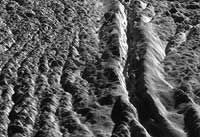|
COMETS EARTH JUPITER KUIPER BELT MARS MERCURY METEORITES NEPTUNE OORT CLOUD PLUTO SATURN SOLAR SYSTEM SPACE SUN URANUS VENUS ORDER PRINTS
PHOTO CATEGORIES SCIENCEVIEWS AMERICAN INDIAN AMPHIBIANS BIRDS BUGS FINE ART FOSSILS THE ISLANDS HISTORICAL PHOTOS MAMMALS OTHER PARKS PLANTS RELIGIOUS REPTILES SCIENCEVIEWS PRINTS
|
Related Documents
Download Options
This perspective view of Damascus Sulcus was generated using high resolution images of Enceladus acquired in August 2008 at 12 to 30 meters (40 to 100 feet) resolution, together with a new topographic map of the region produced by Dr. Paul Schenk (http://www.lpi.usra.edu/lpi/schenk/) at the Lunar and Planetary Institute in Houston, TX. Damascus Sulcus is one of several prominent linear structures, dubbed "tiger stripes," within the geologically active south polar region of Enceladus. Damascus Sulcus consists of two large parallel ridges separated by a deep V-shaped medial trough. The ridges are each 100 to 150 meters high (325 to 500 feet), while the entire width of Damascus Sulcus is 5 kilometers (3 miles). The medial trough between the ridges is 200 to 250 meters (650 to 820 feet) deep, and may have formed by daily shear (sliding) faulting triggered by tidal forces. These medial troughs may be the primary source of numerous jets making up the large active water vapor plume over the south pole of Enceladus. Several small ridges can be seen along the floor of the medial trough. These could be blocks of crust that have slid down the walls of the trough or fractured blocks pushed up from below. Flanking Damascus Sulcus are repeating sets of broken and disrupted parallel ridges a few tens of meters high. These are typical of the plains that lie between the tiger stripe structures and resemble crumpled or folded rock patterns seen on Earth. Relief has been exaggerated by a factor of ~10 to enhance clarity. |
